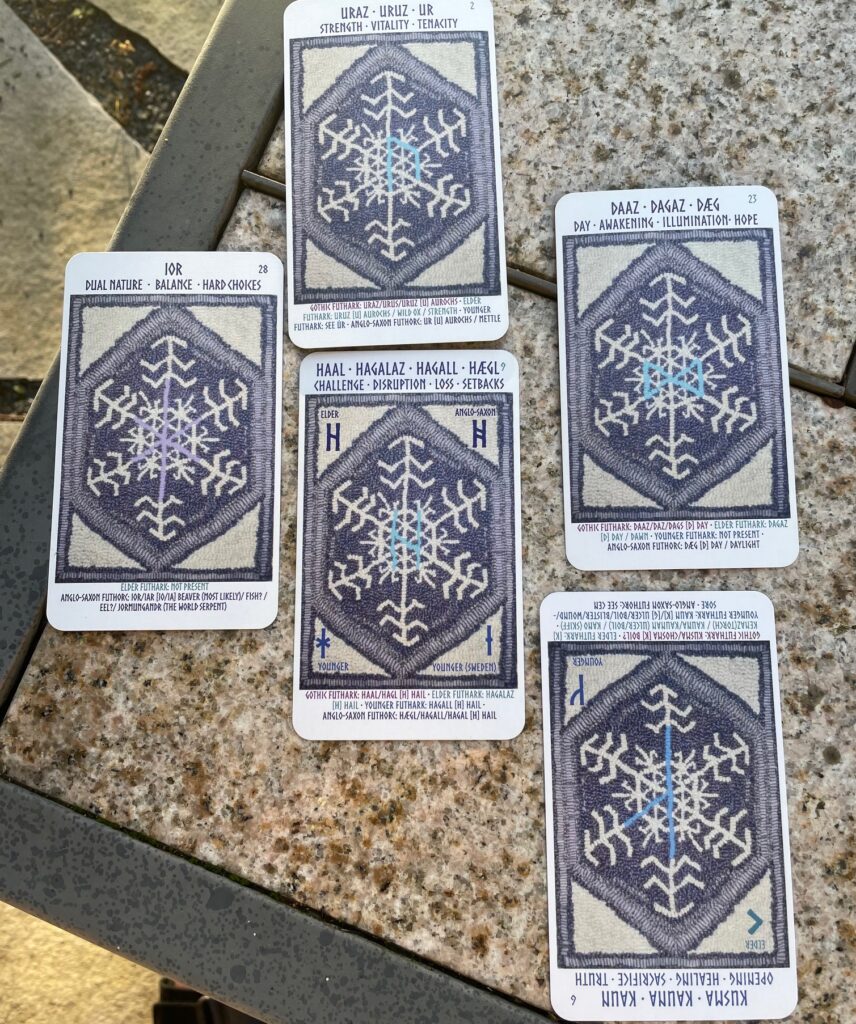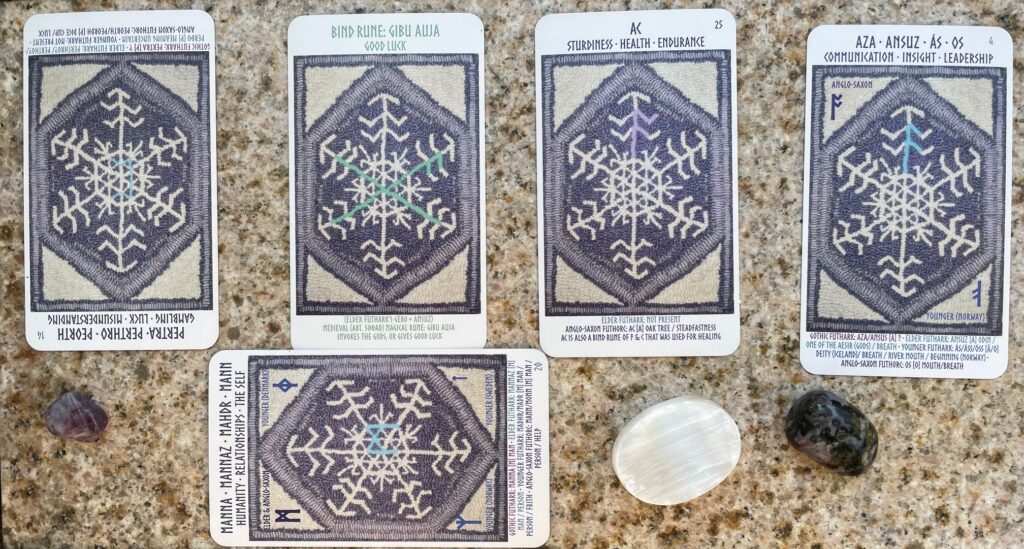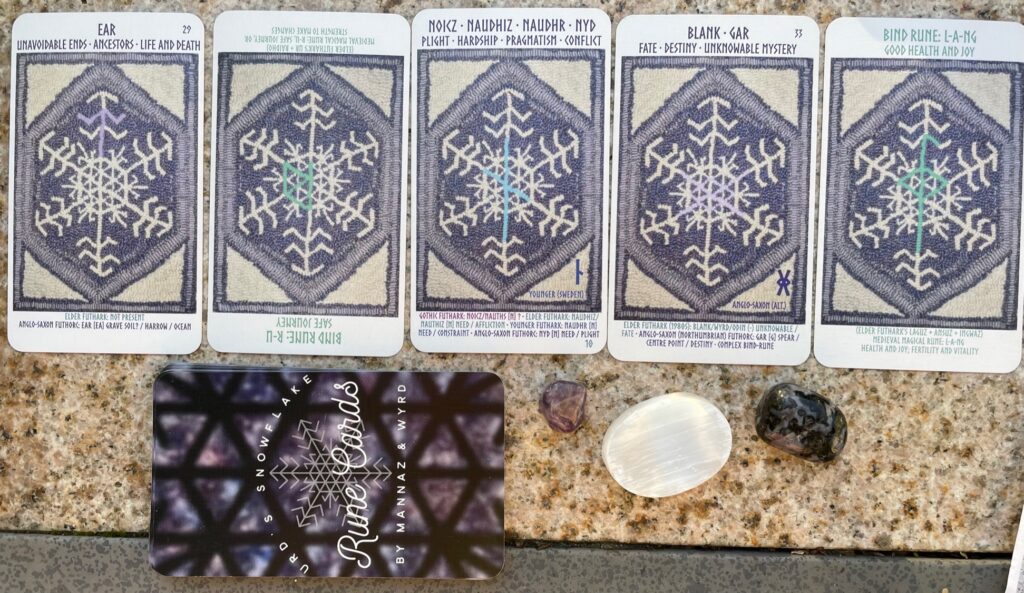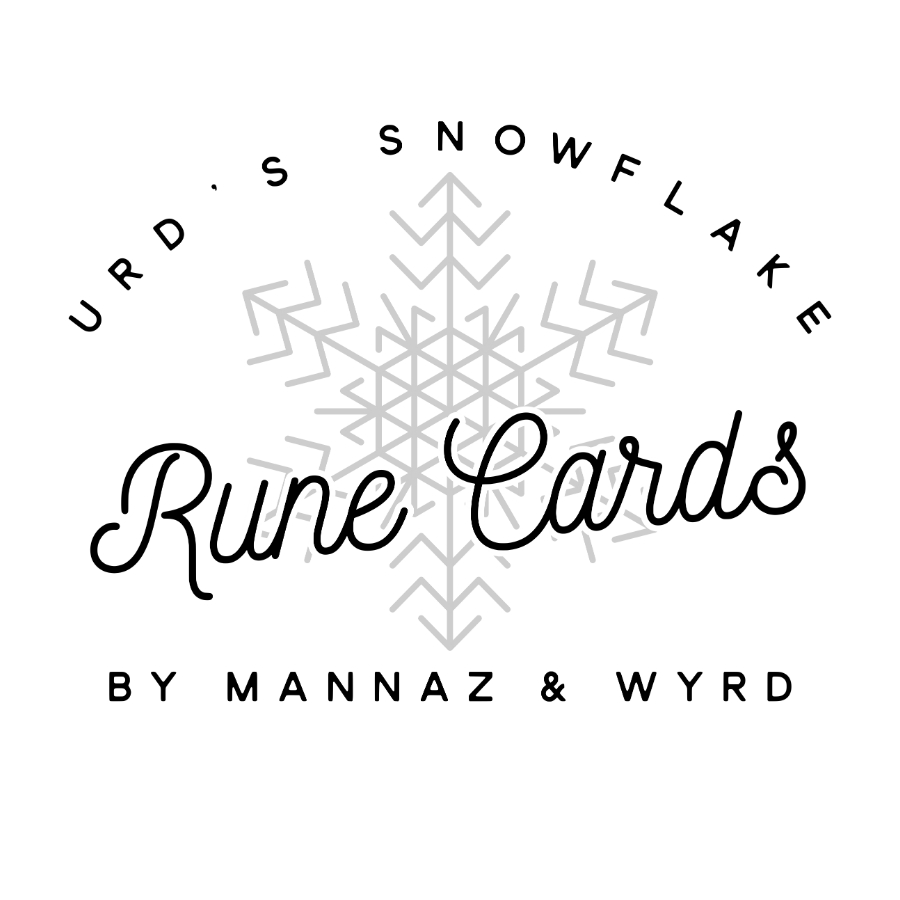reposted from Eira’s 4 Nov 2021 Kickstarter update
Dear wonderful backers and friends of the rune card project,
First, the good news: all backers should now have recieved all their rewards (let me know if you haven’t!).
However.
I am writing today with upsetting news.
Some of the runes on cards in the project were sourced from influential mass-market rune books by author Nigel Pennick, who was recommended to me by people I trust. Pennick is responsible for the runic half-months, the ‘reconstruction’ of runic astrology, and his books are the source of probably 95% of the bind-rune art sold on Etsy. Unfortunately, his 1970s-early1980s writing turns out to (at best) uncritically propogate information from pre-WW2 German ‘rune scholars’ or (at worst) knowingly rebrand Nazi mysticism for a modern audience (link is a tumblr post from the evening of Oct 22nd; getting my hands on his out-of-print books wasn’t trivial, almost as if they’d been buried on purpose). His ‘Erda’ rune appears to be Odal with the serial numbers filed off — and Odal (from the Nazi Armanen Runes, essentially Othala with added lines that look like serifs) is commonly used these days as a fascist/neo-Nazi dog whistle. Now, it’s still possible that Pennick was quoting pre-Nazi sources and ‘Erda’, like so much else, was stolen and repurposed by the Nazis — but I can no longer trust that’s the case, so the “among runes misused by Nazi Germany & extremists” at the base of the card is no longer sufficient.
SO. I am mortified that I included Pennick as a trusted source (and to be clear, this error is mine alone, my writing partner Lee wasn’t involved), and you all have my abject apologies.
Last week, I postponed the small monthly rune study group I’ve been running so I could get to the bottom of this (and make sure none of the “modern divination keywords” column in the booklet is suspect), and put off finalizing the planned lesson plans for teens yet again (I now believe they’ll need external experts’ help to vet before I can even release them for testing). This morning, I have withdrawn the remaining card decks from circulation via Etsy (and this afternoon I’ll go grab the handful of decks at local retailers, which fortunately have not sold). I am going to give the free PDF booklet a rewrite. I will look at the math and see if I have any wiggle room from this at-cost pilot-project offering to provide you with some kind of refund. And I’ll confer with my gothi to see if there’s anything else I might do to make this error right.
If you choose to keep your deck, please remove and destroy the following cards, as their source is now considered highly suspect. (All remaining cards came from academic runology sources and should be okay to continue using, but I may need to further update their associated divination keywords.)
Bind Rune: Erda, Bind Rune: Ziu, Bind Rune: Sol, Wan, Wendhorn (all cards with coral highlighting).
Bind Rune: L-A-NG, Bind Rune: M-A, Bind Rune: R-U, Bind Rune: T-O-R, Bind Rune: Stan-knot,
Bind Rune: J-O-G (all cards with green highlighting)
Of the remaining green-highlighted bind rune cards, Gibu Auja and stacked Tiwaz (so-called Tyr’s Spears) are attested as inscriptions in those forms, and A-L-U is (IIRC) only inscribed as a series of letters.
McLeod & Mees discuss all three in their book on runic insciptions that appear to have had magic intent to their users. Depending on how you feel about bind runes, you may keep or remove those from your decks.
I’d like to express my gratitude to my friend Avelix, who handed along the deservedly-harsh feedback of the users of Ocean Keltoi’s discord server, and to my fellow Tumblr users Obligate-Rebel and Thorraborrin who’ve been journeying down the rabbit-hole of 1970s rune divination with me and helping to uncover how deeply warped the dawn of modern rune divination was, and to all of you for supporting me on this journey.
I hope that by being as transparent as possible, and continuing to work diligently on the free resources that came out of this project, I can re-earn your trust in my judgment. Again, my deepest apologies.
– Eira
Download the outline (PDF) of what we’ll discuss over several meetings.
Our first session will run Oct 3rd, noon EST on the Diviners Anonymous community Discord server.
(I will update this post as we go with study guides, links, and lesson plans.)
4 Nov update: the study group is on hiatus while I sort out the issue with materials that turn out to have been poorly sourced (see latest blog post).
From our Tumblr feed, a conversation with @thorraborinn about tracing the missing links between known ethnic-nationalist rune users in 1920s Germany and Austria and the rune revival starting in 1980. (Update: this was followed by a series of tumblr posts by @obligate-rebel, @thorraborinn, and myself… when I get a chance I’ll add those links to this blog as well.)
TL:DR, fleshed out with the help of Open Library and Nigel Pennick’s bibliography in his The Complete Illustrated Guide to Runes (1999), the timeline from 1900 onward currently looks something like this:
- Viennese mystic Guido “von” List (1902) plagiarizes/adapts the Younger Futhark and popularizes it as the supposedly-primordial-and-channelled-to-him Armanen Runes. Das Geheimnis der Runen is published in 1908, and his ideas are spread by members of the Armanen Orden.
- German gnostic Ernst Tristan Kurtzahn publishes Die Runen als Heilszeichen und Schicksalslose in 1924.
- The Armanen Orden’s half-baked half-faked runelore is used as Nazi propaganda and imagery by the Third Reich, then is banned following World War II. This may include rune books from the period by Rudolf John Gorsleben (1930), Siegfried Adolf Kummer (1932), Hermann Wirth (1931-36), Wolfgang Krause (1935), Oskar von Zaborsky (1936), Walther Blachetta (1941), Edmund Weber (1941), Helmut Arntz (1935, 1944), and Friedrich Bernhard Marby (1931, 1933, 1955, 1957) — although some of these authors would have been academics of the period forced to work with the regime.
- Kurt Spiesburger (Runenmagie, 1955) attempts to remove Nazi racism from Armanen runes. Also during this post-war period, rune books are also published by Anders Baeksted (in Danish, 1952), Franz Altheìm (a German historian, 1948), Sven Birger Fredrik Jansson (in Swedish, 1940 & 1966), and Jorgen Glahder (in Danish, 1952).
- 1960s-70s scholarly works by runologists and historians in English include Ralph W. V. Eliot Runes: An Introduction (1959), Sven B.F. Janssen The Runes of Sweden (1962, translated by Peter G. Foote), R.I. Page An Introduction to English Runes (1973), and J.M. Kemble Anglo-Saxon Runes (1976). Non-English-language books are released by scholars Klaus Duwel (1968) and Wolfgang Krause (1970) .
- 1960s or 1970s Californian rune tiles (per Pennick, p159 of Complete Illustrated Book of Runes) and (presumably) magazine articles by Athene Williams eventually lead first to a chapter on runes by Williams in a 1975 mass-market book titled The Fortune Tellers, followed by celebrity clairvoyant Kim Tracey’s mass-market 25-rune divination set (including a blank!), published 1979 and sold in the UK & Commonwealth.
- Meanwhile, somewhat-more-scholarly esoteric rune books are published by The Caudron magazine editor Michael Howard (The Runes and other Magical Alphabets, 1978), Nigel Pennick (Ogham and Runic Magical Writing of Old Britain and Northern Europe, 1978), and tarot author Carlyle A. Pushong (Rune Magic, 1978, compares Elder Futhark and Armanen runes and plagiarizes Spiesburger per a Goodreads reviewer). Otto Zeller’s German-language divination book of 1977 may have inspired this group of authors. 9Nov2021 edit: both Pennick and Howard spill much ink discussing the swastika’s history, and Pennick appears to be uncritically reading and citing pre-WW2 German mystics for their “practical esoteric knowledge” during this period. Y i k e s.
- Ralph Blum’s first rune book with tiles is published 1980 in US, widely considered the watershed point that leads to more books by Howard and Pennick, Flowers-Thorsson and many other popular rune authors. The Rune Guild is founded in 1980 in Austin TX by Stephen Flowers, aka Edred Thorsson, whose first book (1980) is focussed on Armanen runes. Rune cards first appear in the 1980s as well, Tricia Bramwell’s The Phoenix Runes (1983) being the earliest I’ve found a reference to.
[reposted from our Kickstarter update of 22 Sept 2021]
Hi everyone! My apologies for not sending updates since late June. Let me catch you up!
1. At this point, all of you who asked for only decks of cards, or agreed to a swap from resin to opalite rune dice, should have had your rewards delivered. As our update title says, that’s all but 8 of you. To the eight still waiting: thank you so much for your patience, I hope to be able to reward it with backer rewards of the highest possible quality and craftsmanship.
2. I took July off of this project so I could travel to visit my family and help my widowed mother-in-law. Fully-vaccinated long-overdue hugs from moms and dad: highly recommended.
3. We (me & the teens at Ravishing Raven Handmade) are *still* having trouble with the resin dice made using sprue molds, and the two-part molds leave us with giant bubbles to fill. I’m far from confident that they’d give a random result upon rolling. We’re also having trouble making the last altar-tile/coaster, possibly something about the gemstones chosen affecting the way the resin cures. It keeps doming! We’re now trying hand-pouring it in much thinner layers to overcome this issue. Hopefully that will work and we can ship that to you soon; the other three are done and are shipping as the divination cloths are done (see no.6).
4. So, as I suggested in June, for as many of you as were interested in the swap, we engraved opalite cubes to act as rune dice, and wrote up a set of instructions for them. The hold-up here ended up being the sourcing of enough opalite that was close enough to a perfect sugar-cube shape to work properly as a die… most tumbled opalite ‘cubes’ actually aren’t. And the worldwide pandemic’s knock-on effects on supply chain management meant that took a few weeks, and three of the Canadian crystal shops on Etsy really came through by sending me the most cube-y cubes they had in stock. (I also have a huge pile of ‘seconds’ now to find another use for.) I also needed to replace my dremel – turns out a faulty motor was responsible for the vibration that was severely limiting how long I could engrave at a time. But we’re really pleased with the results, which should be in your hands by now:

5. For the handful of you who really wanted one-aett-per-D8 dice, we’ve come up with an alternative to resin: fluorite octahedrons. Again, finding ones that are close enough to a perfect octahedron to work, that are also close enough to our price point that we don’t take a bath *and* available from suppliers we trust to have ethical sourcing, is tricky. Here’s how the first set looks after hand-engraving and painting the Elder Futhark:

They also feel lovely in the hand. I hope to source enough truly-octagonal fluorite octagons to make these in place of resin for everyone who still wanted the D8 shape.
6. That leaves the batik divination cloths! Making these is very, very time-intensive, and some cloths in the first two batches made were ruined at a late stage of the process, but I’ve learned a lot and I’m partway into making the final few so I can fulfill the remaining backer rewards that included these.
7. The rune card booklet is available for free download on our website (here) and the lesson plans and rune dice instructions will follow soon.
8. Those of you who have gotten your rewards: please let me know how the cards and dice work for you! Your constructive criticism will help us improve the cards, the dice, and the instructions. We’d also LOVE to see them in use. Tag us @mannazandwyrd or use the hashtags #UrdsSnowflake #RuneCards on Instagram/twitter/tumblr.
For those who celebrate the equinox: happy Haustblot or blessed Mabon! (I *think* we’re all in the Northern Hemisphere?)
– Eira
Yesterday was the first harvest festival of the year, celebrated as Kvasi Fest (see Forn Sidr of America’s post) by Norse pagans, Lughnasadh by our Celtic pagan cousins, and Lammas in the Wiccan-created wheel of the year. Over on Diviners Anonymous we did another set of group divinations. (You can find some of the spreads used below in our free rune booklet (PDF).



(Edited 3Dec2022) Version 1.3 of Urd’s Snowflake Rune Cards’ Booklet is now available to download for free!
(Edited 6Dec2021) Version 1.2 of Urd’s Snowflake Rune Cards’ Booklet is now available to download for free!
(Edited 9Nov2021) Version 1.1 of Urd’s Snowflake Rune Cards’ Booklet is now available to download for free!
This 14 page booklet was written as part of the Urd’s Snowflake Rune Cards project, which grew out of a need to vet information about runes and remove misinformation, white supremacy, and cultural appropriation while re-grounding rune divination practice in current academic research on the primary and secondary sources by linguists, historians, and archaeologists.
In version 1.1 all edits from the first edition are in blue italics or crossouts for transparency. These were necessitated by a mass-market popular-history-and-occult source being found to be untrustworthy due to his early books’ completely uncritical handling of material from pre-WW2 German mystics; please see Eira’s full apology here.
In version 1.2 all additional edits are in orange text. These are minor typo corrections, modern divination meanings to use with caution (possibly Armanen, gendered, or unsupported by the rune names & poems), and suggested additional divination meanings.
In version 1.3 all additional edits are in green text. These are small changes to wording, some further flagging of meanings that come from Tarot and I Ching, additional divination meanings from rune poems, additional recommended reading, and additions and alphabetization of the authors-to-avoid list. We believe this will be the final update to the booklet.

[The limited 1st edition of the card deck, which includes Elder Futhark, Younger Futhark, Anglo-Saxon Futhorc, and selected bind-runes (now removed due to our sourcing mistake), was available through Etsy. We have not yet decided if we will make the remaining decks available with the questionable cards removed.]
In the booklet, which can be used without the cards by any rune user, we discuss both the history of the rune rows, and the more recent history of rune divination, and have attempted to pare away ideas that came from von List’s gang of ethnic nationalists, the I Ching, Hermeticism, and Tarot (to the extent that’s possible in a card format). Our suggested divination keywords are drawn wherever possible from current translations of the various rune poems, and do not include reversals. We are currently working to ensure no suspect information slipped through in the divination keywords; however, we are finding the dawn of modern rune divination in the 1970s and early 1980s was awash in appropriation from other practices and sneaky references to the Armanen runes, so it’ll take awhile to complete that process. In a future update, we’ll also share a separate list of spurious divination meanings and why they’re unlikely.
We’ve also done our level best to flag any runes that were stolen by the Third Reich or are currently being misused by white supremacists, and to vet the suggested readings. We’ve provided our (updated!) recommended reading and sources list, and a list of mass-market rune authors to avoid.
Recent Comments